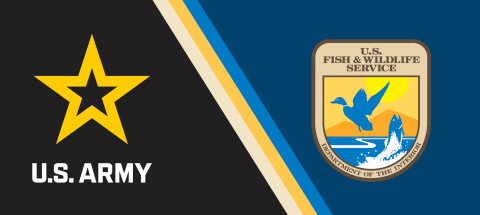Military Conservation
More than 1,300 species of plants and animals face the risk of extinction and receive federal protections under the Endangered Species Act. The biggest threat these species face? Habitat loss and degradation. Yet many species have found shelter in pockets of pristine wilderness – at military installations!
Military installations contain some of our nation’s highest quality remaining rare wildlife habitats and support the highest density of threatened and endangered species of any federal land management agency.
Amazingly, preserving these wild spaces also greatly benefits our nation’s military readiness as personnel gain the opportunity to train on varied and challenging terrain.
The Army Leads the Way
Of the 300 military installations that protect these ecosystems, 157 are operated by the Army – and the Army has stepped up to the plate to protect them.
Throughout 2023 and 2024, a renewed partnership with the USFWS saw the Army dedicating over $13 M to execute new projects in habitat restoration, endangered species preservation, and protecting critical ecosystems.
Valuing not only our natural resources but also those who work to protect them, the Army empowered many early career professionals to execute these mission critical projects across a variety of roles. Interns, Fellows, graduate students, and emerging professionals partnered with the USFWS to protect invaluable plants and animals across Army installations while gaining the experience to flourish in natural resource careers.
Every day, the Army works to preserve our nation’s most at risk ecosystems. This series, In Defense of Our Natural Resources, highlights the success of these projects and of those who made them a reality.
In Defense of Our Natural Resources
Julianne Johnson (she/her) is a Federal Pathways Intern working across three labs in Manoa Valley and the North Shore: Oahu Army Natural Resources Program, Lyon Arboretum, and James Campbell National Wildlife Refuge. After initially pursuing a career as an emergency veterinary technician, funding from the Army and USFWS has equipped her to transition into the federal workforce as a Biological Science Trainee.
Elwynn Sherman is a Biological Field Intern placed at Fort Cavazos, Texas through a partnership with the Army and the U.S. Fish & Wildlife Service. Sherman’s position assists with a wide variety of critical conservation tasks – trapping invasives, monitoring endangered species, and more – all with the goal of preserving native ecosystems at the installation and beyond.
How do you go from chef to conservationist? After working 13 years in the culinary industry, Ryan Saito (he/him) is now a Federal Pathways Intern in Hawaii, working with Lyon Arboretum, James Campbell National Wildlife Refuge, and the Oahu Army Natural Resources Program.
Communication and Conservation
Emily Grace Thompson is a Digital Media Intern at The Fish and Wildlife Service's Headquarters. Her position is funded in partnership with the Army, and her job focuses around supporting youth employment and communicating successes in Army Natural Resources Programs.
Shelby Truckenbrod is a PhD student at University of Massachusetts Amherst. Through a partnership with the USFWS and the Army, she works at Fort Devens in eastern Massachusetts, facilitating partnerships to monitor and research Blanding’s turtles.




